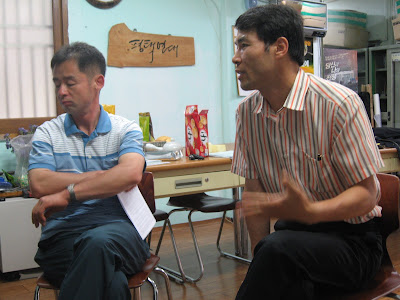SK Solidarity Trip Day 2: Art in Daechuri
 While at the Pyeongtaek Peace Center, I had the chance to meet with Yongdong Yang, an artist and one of the main photographers who captured the resistance of the people of Daechuri village, which was almost completely demolished in order to make way for the expansion of Camp Humphreys. He published a book a few years ago chronicling the fight of the villagers, and I was lucky enough to purchase a copy while I was at the Center.
While at the Pyeongtaek Peace Center, I had the chance to meet with Yongdong Yang, an artist and one of the main photographers who captured the resistance of the people of Daechuri village, which was almost completely demolished in order to make way for the expansion of Camp Humphreys. He published a book a few years ago chronicling the fight of the villagers, and I was lucky enough to purchase a copy while I was at the Center.Unfortunately the book is entirely in Korean and the only thing I can read in it are the dates on which the photos were taken. Nonetheless, many of the pictures are very powerful and a few very brutal. We see in some the simple but direct resistance of people who are fighting for their land, fighting to not lose the land or homes some held in their families for generations, and be forced to live in high-rise apartments like the majority of South Koreans today. But in other images we see the overcompensation of the state, the vast army of riot police that it sent into that tiny village to ensure that no one stood in the way of destroying Daechuri and handing thousands of acres of fertile farmland over to the US military. As the government destroyed more homes and structures, violence eventually did erupt. The book captures some of those photographs.
 When I was doing some research online about the 2006 battle in Pyeongtaek, many articles portrayed the protestors as troublemakers who attacked the helpless thousands riot police who had come to destroy Daechuri village. Articles described the poor police, in their full body armor, shields, batons, helmets and other array of hi-tech crowd control weapons, being helplessly pummeled by farmers with their sticks and bamboo poles.
When I was doing some research online about the 2006 battle in Pyeongtaek, many articles portrayed the protestors as troublemakers who attacked the helpless thousands riot police who had come to destroy Daechuri village. Articles described the poor police, in their full body armor, shields, batons, helmets and other array of hi-tech crowd control weapons, being helplessly pummeled by farmers with their sticks and bamboo poles.One final thing that I found very interesting about this book is how much of a role public art and public community rituals played in the resistance to this base. In the book there are countless images of different paintings, sculptures, icons which people created to express their disapproval for the displacement of the villagers and the expansion of the US military base. I also came across this vide on Youtube the other day, which was filmed after much of the protests had ended and the conflict was over, but was meant to collect as much of the art that the struggle had created.
Here is a message which accompanied the video short, from one of the artists who made it, Bum Lee:
“I visited Daechuri on Saturday March 3. Behind the perimeter of fences guarded by police, many of the homes had been demolished and the unharvested fields were trenched off with barbed wire. But there was art everywhere amidst the ruin – murals, sculptures, junk art, and a gallery filled with paintings. The villagers held their nightly candlelight vigil in a hall surrounded by painted portraits, and in the evening they sang songs around a bonfire.
This video is a tribute to the art of Daechuri.”
Right now I’m in Gaengjong Village in Jeju Island, tomorrow morning we’ll be touring around the village and the island learning more about their struggle against the building of a Navy base in their small village by the sea. I’m wondering what kind of art is being created there to help sustain their struggle, as well as translate it to a wider audience.
Before going, I don’t have a scanner here in Korea but I did want to share on my blog some pictures from the resistance book I bought. I just took these photos with my not-so-great-digital camera and so my apologies to Mr. Yongdong Yang for misrepresenting his work. Later when I get back to Guam I will probably scan some more and post them.








Comments